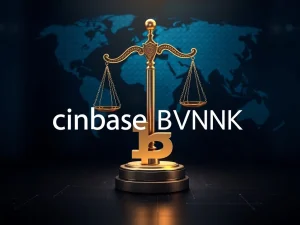New York’s Blueprint: Shaping Federal Crypto Legislation

Get ready to dive into the world of cryptocurrency regulation, specifically how one state’s pioneering efforts are potentially laying the groundwork for the entire nation. That’s right, we’re talking about the significant influence of New York crypto regulation on the evolving landscape of federal crypto legislation.
New York’s Pioneering Approach to Crypto Regulation
For a decade, New York State has been at the forefront of cryptocurrency regulation in the United States. It established the nation’s first comprehensive regulatory framework for crypto businesses. This framework included essential guidelines for consumer protection, anti-money laundering (AML) compliance, and cybersecurity.
A key element of this approach is the BitLicense. Issued by the New York Department of Financial Services (NYDFS), the BitLicense allows companies to conduct digital currency business activities within the state. Early recipients like Circle and Ripple went on to become major players globally. Today, the NYDFS oversees a substantial number of crypto firms and is often seen as a benchmark for crypto regulation in the US.
Setting the Crypto Guardrails: Insights from the NYDFS
Ken Coghill, the NYDFS’s deputy superintendent for virtual currencies, recently shared insights on the state’s regulatory philosophy. He noted that many firms seeking a BitLicense are new to dealing with regulators and may not fully grasp their responsibility when handling customer assets. Coghill emphasized the regulator’s role:
- Regulators exist because businesses are selling something to others and maintaining control over that product.
- The NYDFS sets the ‘guardrails’ – the basic rules and boundaries.
- The industry must figure out how to operate safely within those established boundaries.
He highlighted that the NYDFS cannot foresee every potential issue but provides essential oversight, particularly where consumer assets are involved.
TradFi Meets Crypto: A Shifting Landscape
Interestingly, conventional financial institutions are increasingly exploring crypto. Large banks are starting to offer services like crypto custody and settlement. Coghill suggests this integration brings the familiar bank model into the crypto space, which can increase comfort for users.
Despite having issued only 22 BitLicenses to date, the NYDFS is prepared for potential growth, especially if more traditional finance firms enter the crypto market. Coghill mentioned that the NYDFS dedicates significant supervisory resources to crypto businesses relative to other financial sectors they regulate, including thousands of banks and insurance companies.
From Dubai to New York: A Regulator’s Journey
Ken Coghill’s path to the NYDFS included 12 years with the Dubai Financial Services Authority, where he led innovation and technology risk supervision and developed a cryptocurrency supervision model. His experience regulating global systemically important banks in Dubai informed his perspective. He chose to join the NYDFS partly because New York and its DFS are widely regarded as leaders in regulation.
What Makes Good Regulation? Applying Crypto Guardrails Effectively
When asked about good regulation, Coghill defined it as regulation that applies appropriate crypto guardrails to reduce risk to clients without prohibiting legitimate activity. He noted that eliminating all risk is impossible and would stifle business. He used the analogy of a pendulum, suggesting regulation swings between being too lenient and too restrictive. According to Coghill, the pendulum had swung too far towards restriction in recent years and is now swinging back.
New York’s Influence on Federal Crypto Legislation
While there’s significant regulatory activity in Washington D.C. concerning crypto and stablecoins, the NYDFS considers it largely business as usual. This is because New York has had rules in place for a decade. Coghill stated that much of the current discussion and potential federal crypto legislation is influenced by New York’s work over the past ten years. The NYDFS actively communicates with federal officials, sharing insights on what regulatory approaches might or might not work.
New York’s model has also influenced other states. California’s recent crypto law, for instance, builds upon New York’s BitLicense and trust charter regulations, despite the BitLicense’s reputation for being strict.
Challenges and Perspectives on Decentralization
The BitLicense hasn’t been without criticism. Some in the crypto industry find its requirements, including the $5,000 application fee, detailed AML protocols, and required audits, too burdensome, particularly for smaller or innovative firms. Crypto exchange Kraken notably left the state after the BitLicense was implemented.
Regarding decentralized protocols versus centralized institutions, Coghill emphasized looking at the product’s actual purpose and underlying intent. Regulators evaluate who it serves and its potential impacts. Their job involves filtering out innovations primarily designed to exploit customers. Regulators examine potential products skeptically, asking how they might negatively impact efficiency or inclusion, rather than simply endorsing them.
The Road Ahead for Federal Crypto Legislation
Predicting the exact timing or outcome of federal crypto legislation is difficult, with the situation changing rapidly. However, the NYDFS continues its work: accepting and processing applications, focusing on core objectives like protecting the market, consumers, and supporting responsible innovation.
Summary: New York’s Lasting Impact
New York’s decade-long experience with New York crypto regulation, spearheaded by the NYDFS and its BitLicense, has created a significant pool of regulatory expertise and a tested framework. This state-level experience is proving to be a valuable resource and a potential blueprint as the United States navigates the complex path towards establishing comprehensive federal crypto legislation. While challenges exist, the foundation laid by New York continues to influence the national conversation around responsible crypto development and oversight.







